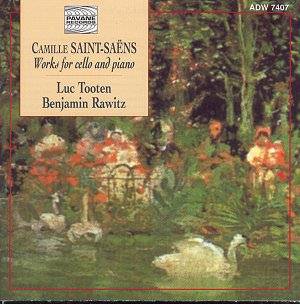Saint-Saëns’ sonatas for cello are underrated.
Though inconsistent in quality they have an ambivalence of tone and
stylistic affinity to compel interest. Not unlike the Elgar Violin Sonata
the Saint-Saëns cello sonatas have recently undergone something
of a discographic fluorescence. Whilst the composer did record some
of his violin works with Gabrielle Willaume – currently on APR – he
never turned to the cello repertoire. Over a decade after his death,
in 1935, cellist Paul Bazelaire and legendary pianist Isidor Philipp
recorded the First sonata, followed two years later by a recording of
the inner two movements of the Second, Op 123 (both now on Pearl). And
for many years that was that. Now however a modest but strong resurgence
of interest in, and acknowledgement of these works has taken place and
one can find recordings by Isserlis and Devoyon (RCA), Lindstom and
Forsberg (Hyperion) and Blake and Palmer (Etcetera). Look hard enough
and you may even come across Andre Navarra’s recording on CAL9818, amongst
other extant offerings. These distinguished advocates have all seen
something of value in works previously shunned as trivial or fatally
uneven.
After a somewhat sombre opening the First Sonata indulges
in some mildly fractious writing. As the cello muses on the lower strings
the piano becomes increasingly dominant and the Janus-faced nature of
Saint-Saëns’ aesthetic becomes clearer. This is a Sonata that faces
both ways, back to the taut Beethovenian and also – this is a work written
in 1872 and roughly bisecting Brahms’ two cello sonatas – to high Romanticism.
The wittily inflected piano introduces a second movement chorale prelude
of warmth, delicacy and undeniable charm whilst the finale builds up
a considerable head of steam, in some ways anticipatory of Saint-Saëns’
pupil, Fauré. If I have a criticism it’s that the movement isn’t
quite distinctive enough. By the time he came to write the Second Sonata,
in 1905, he gave more freedom and flexibility to his paragraphs and
the opening movement emerges as a feely evolving romantic argument,
though not one discursive enough to imperil architecture. I did find
Tooten and Rawitz very occasionally laboured in the passagework but
otherwise their conformity and synchronicity of approach pays dividends
here. Tooten has a lean tonal profile and is a flexible player. The
scherzo is an example of Saint-Saëns’ unselfconscious command of
variation form. First Rawitz and then Tooten introduce their fugal entries
from 5’12 with almost finessing clarity and delicacy as Saint-Saëns
plays some sophisticated games of musical hide and seek. There is some
warmly expressive and cogent playing in the Romanza. I missed some range
of tone colours from Tooten but this is concentrated and sensitively
phrased and Rawitz is a most refined and intelligent player. There is
soft pliancy from both in this song without words. They ride the crest
of the robust, slightly disappointing finale with considerable aplomb
and deal equally well with the small make-weights; the Allegro Appassionato,
much recorded, is good without being outstanding and Le Cygne is
unsentimentalised.
The sound quality has clarity but is somewhat distant.
There are times, especially in the earlier Sonata, when the balance
is awry and the piano overpowers the cello. But these are sensitive
and persuasive performances of works that are increasingly being taken
into the living repertoire.
Jonathan Woolf

![]() Luc Tooten, cello
Luc Tooten, cello
![]() PAVANE ADW7407 [63’28]
PAVANE ADW7407 [63’28]